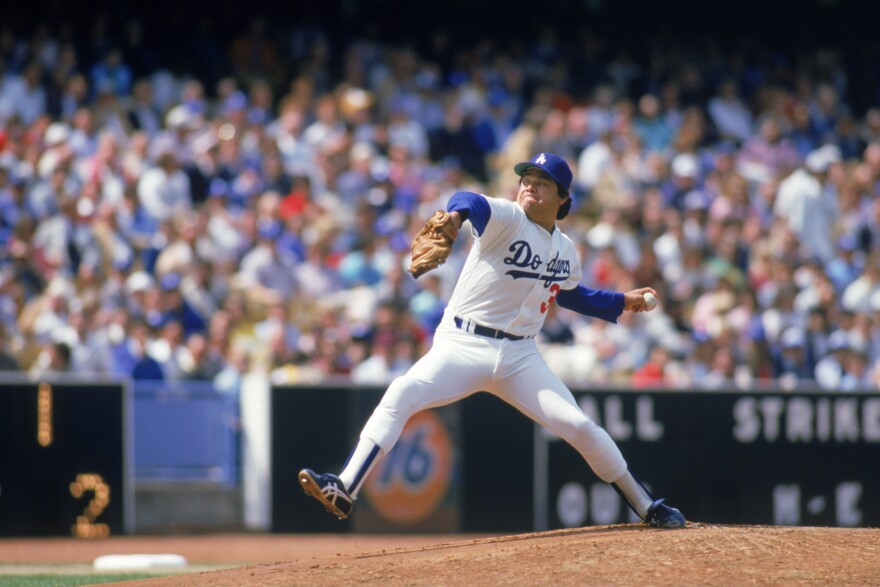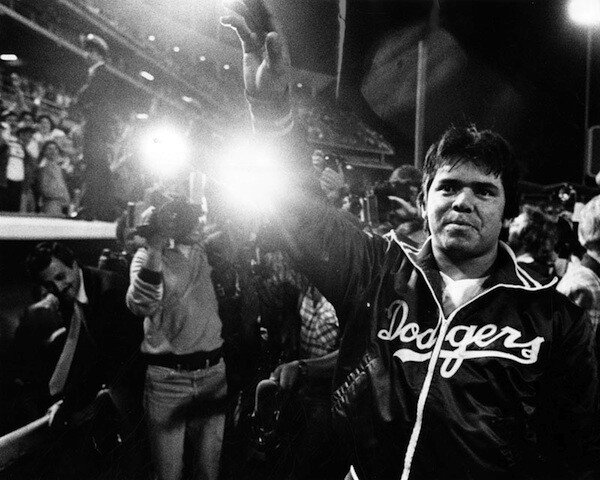Truth matters. Community matters. Your support makes both possible. LAist is one of the few places where news remains independent and free from political and corporate influence. Stand up for truth and for LAist. Make your year-end tax-deductible gift now.
‘Fernandomania’ Returns: The Dodgers Are (Finally) Retiring Fernando Valenzuela’s Number

In the early 1980s, Los Angeles was gripped by “Fernandomania”: fans, many of them Latino, packed Dodger Stadium to see a lefthander from Mexico with a confounding screwball.
On Friday, more than 40 years after his debut in 1980, the Dodgers will celebrate Fernando Valenzuela and his storied career when they retire his number 34 jersey in a pre-game ceremony at Dodger Stadium; earlier Friday, Los Angeles city leaders declared Aug. 11 as “Fernando Valenzuela Day.”
But there’s much more to Valenzuela’s Dodger legacy than his pitching, said Jaime Jarrín. The Dodgers’ longtime Spanish-language sportscaster, now retired, befriended Valenzuela back when he joined the team, acting as his translator — and later, as Valenzuela’s partner in the broadcast booth.

“He became right away a hero for Latinos following baseball,” Jarrín told LAist. “The most important thing is that he created so many new baseball followers.…people from Mexico, from Central America, from South America that didn’t care at all about baseball.”
The young, Mexican-born pitcher rose to superstardom after he led the team to the 1981 World Series. Valenzuela went on to play for the Dodgers until 1991. His pitching appearances drew sell-out crowds and spiked TV viewership.
When Valenzuela came along, Latino sports fans in L.A. at the time were more interested in soccer and boxing, Jarrín said. But when the young man Jarrin describes as “a 19-year-old kid, a little chubby, with Indian features and long hair,” took the pitcher’s mound, Mexican Americans and Latinos in L.A. and elsewhere noticed.
“I think he made them feel proud of being Latinos here in this country,” Jarrín said. “That is what he told me many times, ‘I am very, very proud of being Mexican, and of being Mexican and being here in the United States, here in the major leagues.’ So really, he became an idol here.”
‘El Toro’
Valenzuela was born in Etchohuaquila, a small town within the municipality of Navojoa in Mexico’s Sonora state. He began his professional baseball career in Mexico in 1977, drawing the attention of Major League Baseball scouts two years later, and officially joined the Dodgers at the end of the 1980 season.
He rose quickly to stardom the following year, starting out the 1981 season with a series of shut-out wins, appearing in the All-Star game, and eventually leading the Dodgers to their World Series victory over the New York Yankees that year.

The Fernandomania buzz grew as Valenzuela won both the Rookie of the Year and Cy Young awards. Fans nicknamed him “El Toro,” Spanish for “the bull.”
Valenzuela continued to pitch for the Dodgers until 1991, then went to play for a number of other teams — including the California Angels, San Diego Padres, and Mexico’s Águilas de Mexicali — before retiring from the game.
He continues to work in baseball as a Spanish-language radio color commentator, and spent several years in the Dodgers radio booth alongside his old friend Jarrín.
The legacy of Fernandomania
Jarrín credits Valenzuela with helping change the makeup of the Dodger fan base. He remembers the old days at the stadium, when just a handful of Latinos attended games, usually seated in the top deck.
“When I started with the Dodgers in 1959…the Latinos coming to the games were about 8 to 10%. Now it’s between 45 and 48% in Dodger Stadium…it’s amazing, it’s fantastic, the way that the Latinos are following the Dodgers.”

And while Jarrin has certainly played a role, “(Valenzuela) was the number one guy. He deserves most of the credit.”
“He was able to create that pride that Mexicans and Latinos in general have had in being in the United States and contributing to it,” Jarrin said. “So I think the legacy is huge.”
Fernandomania redux
Fernandomania will be back throughout this weekend with special ceremonies and giveaways in honor of Valenzuela. Tonight, his number will be raised up in left field alongside Dodger legends, including Jackie Robinson, Duke Snider, Sandy Koufax and Valenzuela’s longtime manager, Tommy Lasorda. Fans attending Saturday night’s game will receive commemorative Valenzuela bobbleheads, and on Sunday the team will hand out replica 1981 World Series rings.
And as the weekend starts, Valenzuela’s fan legacy can be glimpsed around town. Earlier this week, shelves at the Latino-owned sports apparel shop The 4th Quarter in Highland Park were brimming with Fernando-themed Dodger T-shirts, while No. 34 Valenzuela jerseys hung from the wall.

Heidi Bringuez, a second-generation Dodger fan who has run the store with her brother for 14 years, said they began stocking up on Valenzuela-related merchandise once they learned that his number would be retired.
“We stocked up on a lot of T-shirts and jerseys, and a lot of it is selling online,” said Bringuez, whose family is Mexican and Guatemalan. She expected more local fans to stop by before Friday’s game.
Bringuez said while Fernandomania happened well before she was born, she grew up with Dodger lore in a family of baseball fans. Especially as a Latina, she said, she is well aware of Valenzuela’s legacy.
“If you pay attention to the majority of the people that attend the games, it’s probably more than 50% Latinos at this point, right?” Bringuez said. “And I think that has a lot to do with the fans he created.”







